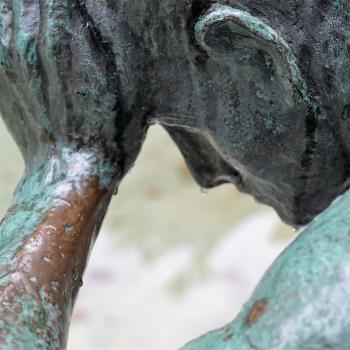
Our last great voice of this series is St. Augustine, the great Western thinker and writer who died in north Africa as the Vandals attacked the city gates. Here is one of those individuals in history who got in the talent line more than once. His ability to think clearly about complex ideas, to express deeply spiritual truths in compelling ways, to pastor and lead a congregation, to pray and imagine beyond the horizons, to probe his own soul (even to the point where readers have said, “Enough already!!”), to love and desire and yearn for the Lord … it just goes on and on.
(Of course, aside from the Lord, who gives all good gifts, we really should thank Monica, the woman who wept and prayed and harassed Augustine into the kingdom. As Augustine tells it,
You stretched out your hand from on high, and delivered my soul from the depths of darkness when my mother, your faithful one, wept to you on my behalf more than mothers weep the bodily death of their children. For by the faith and spirit that she had from you, she saw that I was dead, and you heard her, O Lord. You heard her and did not reject her tears when, pouring down, they watered the earth under her eyes in every place where she prayed. Yes, you heard her.
Then Augustine goes on to relate a dream his mother had, a dream that filled her with joy and sustained her hope and prayers for another nine years before Augustine came to faith. In the dream, “a bright youth” comes to his mother, “joyous and smiling on her, while she was grieving and bowed down with sorrow.” When asked the reason for her weeping, she told of her son.
I love the next line: “He told her to relax…”
Relax! Take a chill pill.
And then Augustine adds, in her dream “where she was, there was I also.” This Monica took as a promise from the Lord that her rock of faith would also be her son’s. Eventually. And so Augustine celebrates God’s love with that luminous affirmation: “O Good Omnipotent, you care for each one of us as if you cared for that one only, and for all as if they were but one!”
Oh, and one last curiosity. Lest you think of Monica as too precious for her own good, she did have a bad habit of drinking a bit too much, to the point where one of her servants actually called her a wino. Prayer—even prevailing prayer—does not demand perfection. Tenacity seems to be more important than flawless virtue.)
So, back to Anatolios… His last major chapter he entitles “Augustine’s De Trinitate: Trinitarian Contemplation as Christological Quest.” Augustine shapes the whole conversation about understanding the Trinity as a quest, a pilgrimage. It is not enclosed in propositional truths about God, as though we can define him. It is not captured in formula that tells us all we need to know about God. Contemplating the Trinity—loving the Triune God—demands a dynamic movement toward him, a growth in faith and reason. (So even if you understand the Trinity no better after this series, I can always hope that you have been launched into a passionate pursuit of the Three-in-One. Here’s an ancient Trinitarian prayer to help you: Holy Lord, Holy and Mighty, Holy Immortal One, have mercy on us.)
When Augustine talks about faith and reason, he does not dispute the valid place of human reason, but does challenge reason as a starting point in the discussion about God. When we try to understand God first out of our places of experience or knowledge or understanding, and move from that into the work of coordinating those realities with God-given revelation, we will always err. We cannot … ever … reach the truth about God’s goodness, love, and holiness by starting with our own impressions or constructs. The “starting point of faith” (initio fidei) can only begin with God’s revelation.
Anatolios tells us that the movement of faith is a dialectic of God descending in revelation and our ascending to him in purification. Knowledge of God is not a thing; it is a way. And the way is actually a person, Jesus Christ. And the way comes to us, not first through our reason and understanding, but first through the action of God in descending to us in Christ. This Anatolios calls the “christodramatic center” of Augustine’s reflections on scripture.
Christodramatic center!! What a brilliant turn of phrase to describe the truth of creation-redemption-sanctification in God’s wisdom. We have a metanarrative—a grand teleological arc—that makes sense of the entire process of human experience and history, and launches us into “the measure of all the fullness of God” (Eph. 3.19).
In his great Trinitarian study, De Trinitate, Augustine begins his description of this metanarrative by studying the theophanies of the Old Testament—the appearances of God. Some examples: the burning bush, the three men visiting Abraham, the Wrestler, the pillars of cloud and fire guiding Israel through the wilderness, etc. All of these, Augustine insists, are signs of what God intended to do in Christ. Whereas in the Old Testament, all of these signs preserve the utter otherness of divine transcendence, and only give hints about God’s presence, in Christ we have the gap bridged: the divine self-disclosure is enclosed with humanity in one unified person, Jesus. Jesus Christ becomes for us both the visible presence of God in history and the promise of the fullness of God in glory: the human entry point into the knowledge of God.
As we study the scriptures, recognize the Trinitarian character of God’s being and action, and then acknowledge the brokenness of our relationship with him, we are prepared to discover the “christological regimen of faith” that enables us to move into the fullness of Trinitarian contemplation.
The whole thing—from creation through the gospel and into the future unknown—is designed to lead us into the vision of God. “Trinitarian theology is primarily and ultimately a Christological quest; the goal is to learn, in Christ, why and how to seek God as Trinity” (Anatolios). Christ is the center because in his humanity we have a tangible, physical sign that anchors our faith; in his divinity, we have a vision of the Tri-unity with the Father and the Son. He is the nexus, the turning point, the place of perfect revelation and perfect presence, the place of both historical and future fullness of God. We come to Christ through his humanity, and we there encounter his divinity; we are passed from Jesus’ hand to God’s Hand, in one person, Christ.
So. All good. But how, then, do we “see” Christ? What is this “christological regimen of faith”?
Augustine has five key points in the business of “seeing” Christ. All these point the way on the yellow brick road to the City of God, where we are given “the eternal sight of the contemplation of the divine Trinity” (Anatolios).
No. 1: The first is that….
Photo: Christ the Redeemer, Rio de Janeiro, Brazil; Roberto Moretti, Flickr C.C.
Note to Reader: This series on Trinitarian Spirituality explores the history and spirituality behind the shaping of the Nicene Creed using Khaled Anatolios’ Retrieving Nicaea: The Development and Meaning of Trinitarian Doctrine (Grand Rapids, MI: Baker Academic, 2011) as guide and inspiration. It’s best to begin at the beginning: An Introduction.












